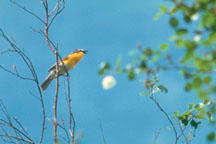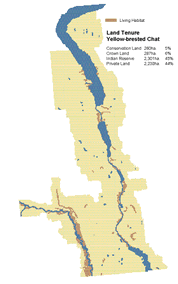|
Habitat Atlas for Wildlife at Risk
Yellow-breasted Chat
Icteria virens

Yellow-breasted
Chat
|

- Length: 18 cm.
- Distinctive white 'spectacles', bright yellow
throat and breast.
Status:
British Columbia Red
List
Canada: Threatened (British Columbia population)
Special Significance
The once common Yellow-breasted Chat is now extremely
rare. In British Columbia, the chat breeds only in
the South Okanagan and Similkameen valleys. Its repeated
whistles, chatters and squawks are sometimes heard
emanating from thick tangles of brush in riparian
areas. These large warblers are in danger of becoming
extirpated in British Columbia because of habitat
loss. Landowners can assist the continued survival
of remaining Yellow-breasted Chat populations by
maintaining and enhancing riparian habitat to provide
the dense, tangled shrub growth favoured by chats.
Livestock should be carefully managed in riparian
areas or excluded by fencing to prevent trampling
of the understory and erosion of streambanks.
Distribution
- In British Columbia, chats occur in the South Okanagan Valley
and along the Similkameen River; most sightings are along
the Okanagan River south of McIntyre Bluff and
near the north end of Osoyoos Lake.
- All breeding records have been south of Penticton,
but territorial birds have been occasionally
heard and seen north to the Thompson Valley and Alkali Lake.
- Chats are restricted to valley bottoms in British
Columbia.
Habitat
- Chats are restricted to dense, low elevation riparian thickets
in dry, open habitats; occupied thickets tend to be damp (not wet)
and
occur along hedgerows, streams, lakeshores or damp
gullies.
- Preferred breeding habitat is dense wild rose thickets
near small deciduous trees such as willows, water
birch and cottonwood.
Reproduction
- Nesting occurs mid-May to June and young fledge by mid-July.
- Birds begin to migrate south in mid-July and most are
gone by mid-August.
Food Habits
- Chats are insectivorous and glean prey from shrub and tree foliage
near ground or on lower branches; berries are also
eaten.
- Nests are usually located less than 3 metres up in
shrubs or small trees.
Interesting Facts
- Song is louder and lower pitched than those of their other wood
warblers; one common phrase consists of three whistles exactly like
someone
calling their dog!
- Chats often sing at night.
Threats
- Clearing of lowland riparian thickets and woods
for agriculture, commercial and residential
developments.
- Livestock trampling riparian vegetation.
- Thinning and logging riparian woodlands.
- Only small areas of suitable riparian habitat are
left after river channelization.
Management Considerations
- Maintain and enhance remaining riparian habitat
including cottonwoods, aspen, rose thickets
and snowberry.
- Avoid clearing or thinning shrubs and thickets
in riparian areas.
- Fence riparian areas to prevent livestock from
trampling bushes or employ a carefully managed
grazing strategy.
- Prevent off-road vehicles from disturbing and
degrading stream-side vegetation.
- Protect known breeding sites from human disturbance.
|
References
1. Cannings, R.A., R.J. Cannings and S.G. Cannings. 1987. Birds of
the Okanagan Valley, British Columbia. Royal British Columbia Museum,
Victoria, BC.
2. Cannings, R.J. 1995. Status of the Yellow-breasted
Chat in British Columbia. Wildlife Branch, Ministry of Water, Land
and Air Protection Lands and Parks, Victoria, British Columbia
|